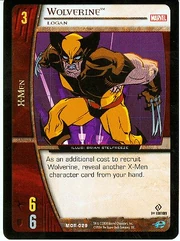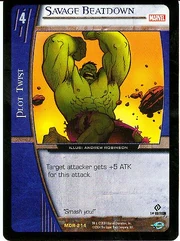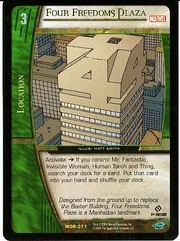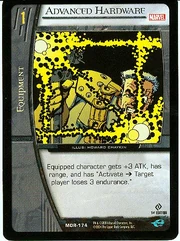
VS System's card back design
VS System[]
"VS System" is the game this wiki is about. If you are completely new to VS, you may want to get an overview by reading Wikipedia's article about it here (or read this page). Later you can return to this wiki for more specific information.
Start[]
VS System is a Collectible Card Game (CCG). This means you'll have to buy cards or receive cards from someone else to start to play. You can buy Decks, Booster Packs or other VS System products, like Starter Decks. The game has been out of print for quite some time, so internet stores will be your best resource for finding VS System cards.
Once you have cards, you can trade with friends or other people. This way, you can trade the cards you can't use in your deck for something you can use. When you trade, look out for the Rarity of the card or its usefulness, or maybe its artwork. VS is a game that has something for everyone.
A deck must contain at least 60 cards. There is no limit on how many cards you can have in your deck, but the more cards you have, the lower the chance you draw your best or favorite card. You can have up to 4 cards with the same name in your deck, unless the card has the version "Army". If a card has the version "Army", there is no limit to how many of that card you can have in your deck. Keep in mind, you can 4 copies of different versions of heroes in the same deck; for example, a deck could legally contain 4 copies of Wolverine, Logan and Wolverine, Berserker Rage.
How do I win?[]
There are two ways to defeat your opponent:
- Every player starts the game with 50 Endurance. Whoever reduces his opponent's Endurance to 0 or below wins at the end of that turn. You can do this by attacking with characters or by playing Plot Twists or using Locations;
- There are some cards which let you win when a certain condition has been met. For example, the card "Rigged Elections" says "If there are 25 or more ballot counters on Rigged Elections, you win the game."
Card Types[]
There are four different card types in the VS System CCG: Character, Plot Twist, Location, and Equipment.You can tell which type a card is by the color of the border.

Character
Character[]
The character cards represent the core of your deck. They are the guys (and gals) that go into combat for you and attempt to beat the opposing team into submission by defeating opposing Characters in combat.
Characters cost resource points to play; during your Recruit Step, you get a number of resource points equal to the number of resources you control, at which point you can recruit Characters into play. Wolverine, Logan costs 3 resource points to play.
Each character has an Attack (ATK) and a Defense (DEF) value listed in the bottom-left corner that are used when that Character is in combat; these numbers are compared against the DEF and ATK of an opposing Character to see who "wins" a given combat. Wolverine, Logan has both an ATK and DEF of 6.
Characters also have a team affiliation, listed on the left-hand side of the card. Wolverine, Logan belongs to the X-Men team. In order to team-attack with multiple characters, they all must share a team affiliation. Also, in order for one character to reinforce another, they both must share a team affiliation.

Plot Twist
In the VS System CCG, characters are unique; this means that only one character with a given name can be in play at a time. The way we differentiate between different versions of the same hero is with the "version", listed underneath the name of the card. The card above has the name "Wolverine", and the version "Logan". If a character is recruited into play, but another character with the same name is already in play, the version that was already in play is put into the discard pile.
Plot Twist[]
These cards represent actions or events that affect in-game play. They could be used to enhance combat, directly effect your opponent or to help improve your deck's performance.
Plot Twists do not cost resource points like characters do; instead, they have a threshold cost. A plot twist is free to play as long as you have a number of resources equal to or greater than its threshold cost. Savage Beatdown is free to play so long as you have 4 or more resources in play. You can also play a Plot Twist at any time, as long as you have priority (this means during both your and your opponent's steps of the turn).

Location
Plot Twists can be played from either your hand or your resource row. Each turn, during your Resource Step, you have an opportunity to put a card from your hand face-down into your resource row. If you put a plot twist into your resource row, you can later flip it face-up; this counts as playing the Plot Twist, and afterwards the card remains in your resource row, face-up, as a resource. If a plot twist is played from your hand, it does to your discard pile after it resolves.
Location[]
A villain's secret lair? A heroic team's base of operations? All these types of locations are represented in the game by the green-bordered cards.
Locations have threshold costs like Plot Twists; in order to use a Location, you must have a number of resources equal to or greater than its threshold cost. Unlike Plot Twists, Locations cannot be played from your hand; Locations can only be flipped face-up in the resource row. When this happens, the Location remains face-up in the resource row, and has some static effect on the game or activated power that you can use (and still counts as a resource!).

Equipment
Equipment[]
A character often relies on a fair selection of hardware to get the job done. These are also represented in the game; they are "equipped" to your character cards to provide them with extra abilities or enhancements. Equipment cards are played using resource points, just like Characters are. Equipment also come into play attached to a character, and leave play when that character leaves play. Like Characters, you can only play equipment during your Recruit Step, and only from your hand, not from the resource row.
Phases of a Turn[]
Players take shared turns; each turn, one player will have the "initiative", which means they take each phase of the turn before the other player. At the end of the turn, initiative passes to the other player.
The phases of a turn are as follows: Draw Phase, Build Phase, Combat Phase, Recovery Phase.
Draw Phase[]
The first thing both players do each turn is draw two cards; this happens during the draw phase.
Build Phase[]
The build phase consists of three steps; Resource, Recruit, and Formation. Each turn, the player with the initiative (or the "initiative player") will complete all three steps of this phase, and then the player to his left will complete all three steps, etc.
At the beginning of the the Resource step, the initiative player has the opportunity to play any card in his or her hand face-down in the Resource row (to the right of any previous resources played). Cards played this way count as Resources, and give that player resource points during the Recruit step.
At the beginning of the Recruit step, the initiative player gets a number of resource points equal to the number of resources he or she controls. Then, that player may spend those resource points on Characters and/or equipment. Resource points do not carry over between turns; any unused points are lost immediately following the Recruit step.
At the beginning of the Formation step, the initiative player has the opportunity to move his or her characters between the front and support rows. After the initiative player completes the Formation step, the game moves to the other player's build phase. Immediately following that, the game moves to the initiative player's combat phase.
Combat Phase[]
The Combat Phase has one step; the Attack step. During your attack step, you can declare attacks between characters. Normally, characters attack one at a time; however, a team attack allows multiple characters to "team-up" and attack one character. To attack with a character, that character must be ready; also, only characters in the front row can attack (unless they have Range, denoted by a crosshair-symbol). Only unprotected characters can be attacked; a character is "unprotected" if they are in the front row or if they are in the support row with no character in front of them. Characters with Flight (denoted by a wings-symbol) can attack protected characters.
After an attack is declared, and before the proposed attacker exhausts, both players have a chance to use effects (like Plot Twists or payment powers), starting with the initiative player. Sometimes, a response may make the proposed attack illegal; in this case, the proposed attack is cancelled and the attacker is not exhausted. Once the attack has begun, again both players have a change to use effects and payment powers. Then, the attack resolves as follows; each character's ATK is compared to the opposing character's DEF, and vice versa. If a character's ATK is equal to or greater than the DEF of the opposing character, the opposing character becomes Stunned. You can become stunned whether you are the attacking character or the defending character; in many cases, both characters in a combat will become stunned as a result of the attack. If the attacker's ATK is greater than the defending character's DEF, then the defender's controller will take breakthrough endurance loss equal to the difference.
Whenever a character becomes stunned, it is exhausted (turned sideways) and flipped face-down, and it's controller loses endurance equal to its cost.
Characters can attack an opponent directly if that opponent controls no non-stunned characters. In this case, the defending player takes breakthrough endurance loss equal to the attackers ATK.
In the case of a team attack, add the ATK of all attacking characters and compare that to the defending character's DEF. The defending character's controller chooses one of the team attacking characters to "fight back", and compares its ATK to only that character's DEF. The resolve combat as normal.
A character in the support row can reinforce an adjacent, defending character of the same team affiliation. To reinforce, simply exhaust the character; then, the defending character is considered "reinforced". When a "reinforced" character is attacked, breakthrough endurance loss is reduced to zero.
Either player can "Power-Up" a character in combat by discarding a character card from their hand with the same name as a character in combat. Powering-Up gives the character +1 ATK/+1 DEF for one attack. You can discard a card with the same name but a different version, the name of the card is all that matters.
Recovery Phase[]
The following things happen in order during the recovery phase;
1. If any player has 0 or less endurance, they lose the game. If all players have 0 or less endurance, the player with the highest (closest to 0) endurance wins the game. If there is a tie, each of the tied players play another turn.
2. Starting with the initiative player, each player chooses one stunned character he or she controls. The players recover those characters, and all other stunned characters are put into the KO'd pile. Recovered characters are still exhausted, but will ready in the next step.
3. Ready all cards in play.
4. Pass the initiative to the next player, and proceed to the next turn.
The Team Affiliations[]
VS System has 18 different expansion sets, and many of them introduced exciting new teams of heroes and villains to the world of VS. Below are brief descriptions of some of the more prominent teams in the VS System CCG.
X-Men[]
The X-Men are a team of mutant superheroes in the Marvel Universe. The basic concept of the X-Men is that under a cloud of increasing anti-mutant sentiment, Professor Xavier created a haven at his Westchester mansion to train young mutants to use their powers for the benefit of humanity, and to prove mutants can be heroes. The X-Men have been a part of VS System since the very first expansion; Marvel Origins. Characters like Wolverine, Cyclops, Rogue, Storm, Professor X, Beast, Nightcrawler, and many others have been featured many times throughout various expansions in VS System, including the X-Men and Marvel Legends expansions.
Brotherhood[]
The Brotherhood of Mutants is a supervillain team in the Marvel Universe devoted to mutant superiority over normal humans. They are among the chief adversaries of the X-Men. Like the X-Men, the Brotherhood team has been a part of VS System since Marvel Origins. Magneto, Mystique, Sabretooth, Toad, Pyro, and others have all been featured alongside the X-Men in the X-Men and Marvel Legends expansions as well.
Fantastic Four[]
The Fantastic Four is a superhero group in the Marvel Universe. They gained their superpowers after exposure to cosmic rays during a scientific mission to outer space; Mr. Fantastic, the Invisible Woman, the Human Torch, and the Thing were among the first superheroes created by Marvel Comics, and have been featured a few times in VS System. Marvel Origins and Marvel Legends were the expansions which featured the Fantastic Four.
Doom[]
Victor von Doom of Latveria (or Dr. Doom) is a supervillain in the Marvel Universe. The son of a gypsy witch named Cynthia Von Doom, Dr. Doom is a main archenemy of the Fantastic Four, and the leader of the fictional nation of Latveria. He is both a genius inventor and a sorcerer, and has been featured throughout VS System's history. Marvel Origins, Heralds of Galactus, and Marvel Legends are the expansions which featured the Doom affiliation, which consisted of Dr. Doom himself along with his various lackeys and robotic creations.
Gotham Knights[]
Bruce Wayne (or Batman) is a superhero in the DC Comics Universe. Bruce Wayne is an American billionaire playboy, industrialist and philanthropist. Having witnessed the murder of his parents as a child, he swore revenge on criminals, an oath tempered with the greater ideal of justive. Wayne trains himself physically and intellectually and dons a bat-themed costume in order to fight crime. The Gotham Knights affiliation is a mainstay of the VS System CCG, being featured in the DC Origins and World's Finest expansions, with some further support coming from the DC Legends expansion. The Gotham Knights team includes Batman, his sidekick Robin, his butler Alfred Pennyworth, and the police commissioner of Gotham City, Jim Gordon, among others.
Arkham Inmates[]
The Elizabeth Arkham Asylum for the Criminally Insane (or the Arkham Asylum) is a psychiatric hospital in the DC Comics Universe that has been home to many psychotic criminals from across the DC Universe, usually archenemies of Batman. The Joker, Poison Ivy, the Riddler, Two-Face, the Scarecrow, Bane, Killer Croc and Harley Quinn are among the villains who belong to the Arkham Inmates team affiliation, and have all been featured in the DC Origins and World's Finest expansions of VS System.
Teen Titans[]
The Teen Titans are a superhero group in the DC Comics Universe. Originally, the Teen Titans consisted of (often teenaged) sidekicks of Justice League members, such as Robin, Kid Flash, Aqualad, Wonder Girl and Speedy. Eventually, they took on their own identity with members such as Cyborg, Starfire, Raven, and Changeling (or Beast Boy). The Teen Titans were featured in the DC Origins and Legion of Superheroes expansions of the VS System, and were quite popular among tournament-players for the synergy between many of their cards.
League of Assassins[]
The League of Assassins is a supervillain group in the DC Comics Universe. Led by Ra's al Ghul, an archenemy of Batman, they are an organization of killers led by Ra's al Ghul's ultimate vision of "a world in perfect balance". The League of Assassins team was featured in the DC Origins and DC Legends expansions.